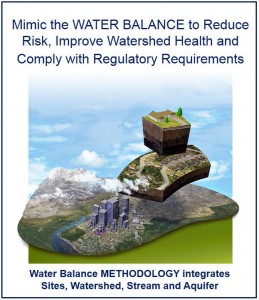Think and Act like a Watershed (Part 4): Water Balance Pathway to a Water-Resilient Future
Note to Reader:
This is a 4-part series. In Part 1, we introduced new ecosystem-based adaptation (EbA) research in BC that may inspire a new generation to “think and act like a watershed”. In Part 2, we celebrated the 20th anniversary of publication of the seminal research by Richard Horner and Chris May. In Part 3, we showcased breakthrough research by Dr. Jenifer McIntyre at Washington State University that builds on the work of Horner and May.
In Part 4 below, we conclude with the parallel journeys of Washington State and British Columbia, California and how the Water Balance Methodology is the foundation for an ecosystem-based approach to protection of hydrologic integrity.
4th in a series connecting past and present research
The primacy of hydrology
 “In 1996, Richard Horner and Chris May (University of Washington) published their seminal research on the cumulative impacts of land use change on stream health. This established the primacy of hydrology. This recognition then led to development of the Water Balance Methodology, adopted by the Province of BC in 2002,” states Kim Stephens, Executive Director, Partnership for Water Sustainability in BC.
“In 1996, Richard Horner and Chris May (University of Washington) published their seminal research on the cumulative impacts of land use change on stream health. This established the primacy of hydrology. This recognition then led to development of the Water Balance Methodology, adopted by the Province of BC in 2002,” states Kim Stephens, Executive Director, Partnership for Water Sustainability in BC.
To Learn More::
Download Primer on Water Balance Methodology for Protecting Watershed Health. The Primer storyline is structured in five parts:
 Part A: Watershed-Based Approach to Rainwater Management
Part A: Watershed-Based Approach to Rainwater Management- Part B: Water Balance Methodology Explained
- Part C: Science Behind the Methodology
- Part D: How to Establish Targets
- Part E: References
For a synopsis of each part, download Table 1. Information is presented in a layered fashion to accommodate the interests of a continuum of audiences.
What Happens on the Land Matters!
“The methodology is evolving as science-based understanding grows,” continues Kim Stephens. “It is the foundation for an ecosystem-based approach to protection of hydrologic integrity, and hence stream system resilience. Recently implemented regulatory requirements in Washington State and California apply the same flow-duration science. Replicating the flow-duration pattern is the way to mimic the natural Water Balance.”
“The Water Balance of watersheds in urban areas is out of balance. A legacy of community and infrastructure design practices has failed to protect the water balance. Restoring hydrologic integrity, and thus the Water Balance, is the pathway to a water-resilient future.”
Parallel Journeys in British Columbia,
Washington State and California
“BC, Washington State and California are travelling along parallel pathways,” states Jim Dumont, Engineering Applications Authority, Partnership for Water Sustainability in BC.
 “Each region has its own terminology, such as hydromodification in California, yet the analytical methodologies have a common ‘flow-duration foundation’. This leads to the same outcome: mimic the Water Balance. A shared vision is to mimic streamflow and duration to limit stream erosion, prevent flooding and improve water quality.”
“Each region has its own terminology, such as hydromodification in California, yet the analytical methodologies have a common ‘flow-duration foundation’. This leads to the same outcome: mimic the Water Balance. A shared vision is to mimic streamflow and duration to limit stream erosion, prevent flooding and improve water quality.”
Flexibility and Effectiveness
“The innovation in BC’s Water Balance Methodology is found in the integration and application of proven scientific and engineering principles. The methodology provides a logical and straightforward way to assess potential impacts resulting from urban development; and analytically demonstrate the effectiveness of the methods proposed for preventing and/or mitigating those impacts.”
“The Partnership for Water Sustainability is evolving the Water Balance Methodology as our understanding of HOW to restore hydrologic integrity grows. The methodology now synthesizes fundamentals of hydrology, flood protection, aquatic ecology, geomorphology and hydrogeology.”
“Our guiding philosophy for application of the Water Balance Methodology emphasizes flexibility, and effectiveness, in optimizing and reducing the costs of the solution.”
Flow-Duration Analysis
“We integrated Flow-Duration Analysis in 2007. Washington State and California have gone a step further and mandated Flow-Duration Analysis as a regulatory requirement in 2012 and 2015, respectively. A commonality is that all three regions are addressing impacts to the stream,” notes Jim Dumont.
“The environmental flows objective of the new Water Sustainability Act opens the door to requiring Flow-Duration Analysis in BC,” adds Kim Stephens. “Within the next few years, the Act will establish regulations pertaining to stream health and aquatic environments. Currently, the Province’s effort is being directed into groundwater protection and regulation, which is of course an important part of the Water Balance.”

This graph illustrates the flow-duration relationship.
Analysis begins with calibration of continuous simulation models using long term climate records, not just selected storms or typical years. The effects of urban development are then estimated and required mitigation measures are sized and optimized.
Implementation of Hydromodification Assessment and Management in California
“Hydromodification refers to alterations in natural watershed hydrology associated with changes in land use or cover,” states Dr. Eric Stein, Principal Scientist – Biology Department, Southern California Coastal Water Research Project. He was an early  champion for a science-based approach to development of an assessment methodology. His agency is an independent public agency funded by 14 other agencies.
champion for a science-based approach to development of an assessment methodology. His agency is an independent public agency funded by 14 other agencies.
“My agency works with federal, state, and local partners to develop strategies and approaches for more effectively assessing and managing the health of aquatic ecosystems. Our goal is to facilitate consensus around the science. We have no policy authority,” explains Eric Stein.
“The genesis for hydromodification assessment and management dates back to 2005 and introduction of the Water Quality Regulation. Because it specified protection of beneficial uses of water, the regulation triggered development of regulatory tools.”
“In 2005, we first recognized that replicating flow-duration is key to preventing erosion impacts. We convened a 2-1/2 day workshop that resulted in a research agenda to move the state to develop tools and build capacity t o use the tools. Collaboration with Derek Booth (Washington State), Brian Bledsoe (then at Colorado State; currently at University of Georgia) other local and national experts was critical to development of a consensus-based road map of projects.”
o use the tools. Collaboration with Derek Booth (Washington State), Brian Bledsoe (then at Colorado State; currently at University of Georgia) other local and national experts was critical to development of a consensus-based road map of projects.”
“Hydromodification assessment and management is becoming a standard requirement that cascades down through regulatory and management programs across Southern California. Most jurisdictions in California address the effects of hydromodification through either a municipal stormwater permit or the statewide construction general permit.”
To Learn More:
Download HYDROMODIFICATION – A Fact Sheet from the Southern California Coastal Water Research Project.
Download Hydromodification Assessment and Management in California, released in 2012. This is a milestone document because it set a direction for implementation of hydromodification management.
Download Story of SCCWRP – Established 1969. It was born as a ‘joint powers authority’, pooling the resources of five local sanitation districts (City of Los Angeles, Los Angeles County, Orange County, Ventura County and City San Diego).
Establish Watershed Targets with
Verifiable Calculations
“The flow-duration relationship is the cornerstone of the Water Balance Methodology,” continues Jim Dumont. “By maintaining flow-duration, stream erosion is not increased during wet weather and ‘environmental flows’ are sustained during dry weather. When homeowners slow, sink and spread rainwater runoff on their property, urban streams benefit.”
 “Protection of streams and fish is an important public expectation in BC, creating a driving force altering our perceptions, aspirations, and treatment of the urban landscape. Water Balance Methodology objectives start with the stream and end with the stream, thereby providing a true measure of success for environmental protection.”
“Protection of streams and fish is an important public expectation in BC, creating a driving force altering our perceptions, aspirations, and treatment of the urban landscape. Water Balance Methodology objectives start with the stream and end with the stream, thereby providing a true measure of success for environmental protection.”
“Understanding how precipitation makes its way to the stream via three pathways, each with a different time scale, allows one to assess how a watershed and stream operate while analytically demonstrating impacts of development and the effectiveness of mitigation works.”
“Managing watersheds as an integrated Water Balance system means:establish watershed targets with verifiable calculations. Then mitigation systems, such as rain gardens, can be optimized for both cost and function,” concludes Jim Dumont.
Coming this Fall…..
In 2014, the Partnership for Water Sustainability released the Primer on the Water Balance Methodology for Protecting Stream Health. Later in 2016, the Partnership will release an updated Primer that elaborates on parallel journeys in Washington State, California and Australia.
The updated Primer will also incorporate a Peer Review / Perspective by Dr. Peter Coombes, former Chief Scientist, State of Victoria, Australia. “It is an exciting story of parallel endeavour – not exactly the same, but similar fundamental principles with  opportunities to learn from each other on the differences,” foreshadows Dr. Coombes.
opportunities to learn from each other on the differences,” foreshadows Dr. Coombes.
“A commonality of understanding between BC and Australia is that we are managing a water balance in a connected system of human endeavour and ecosystem processes.”
To Learn More:
Download Beyond the Guidebook 2015: Moving Towards “Sustainable Watershed Systems, through Asset Management”




